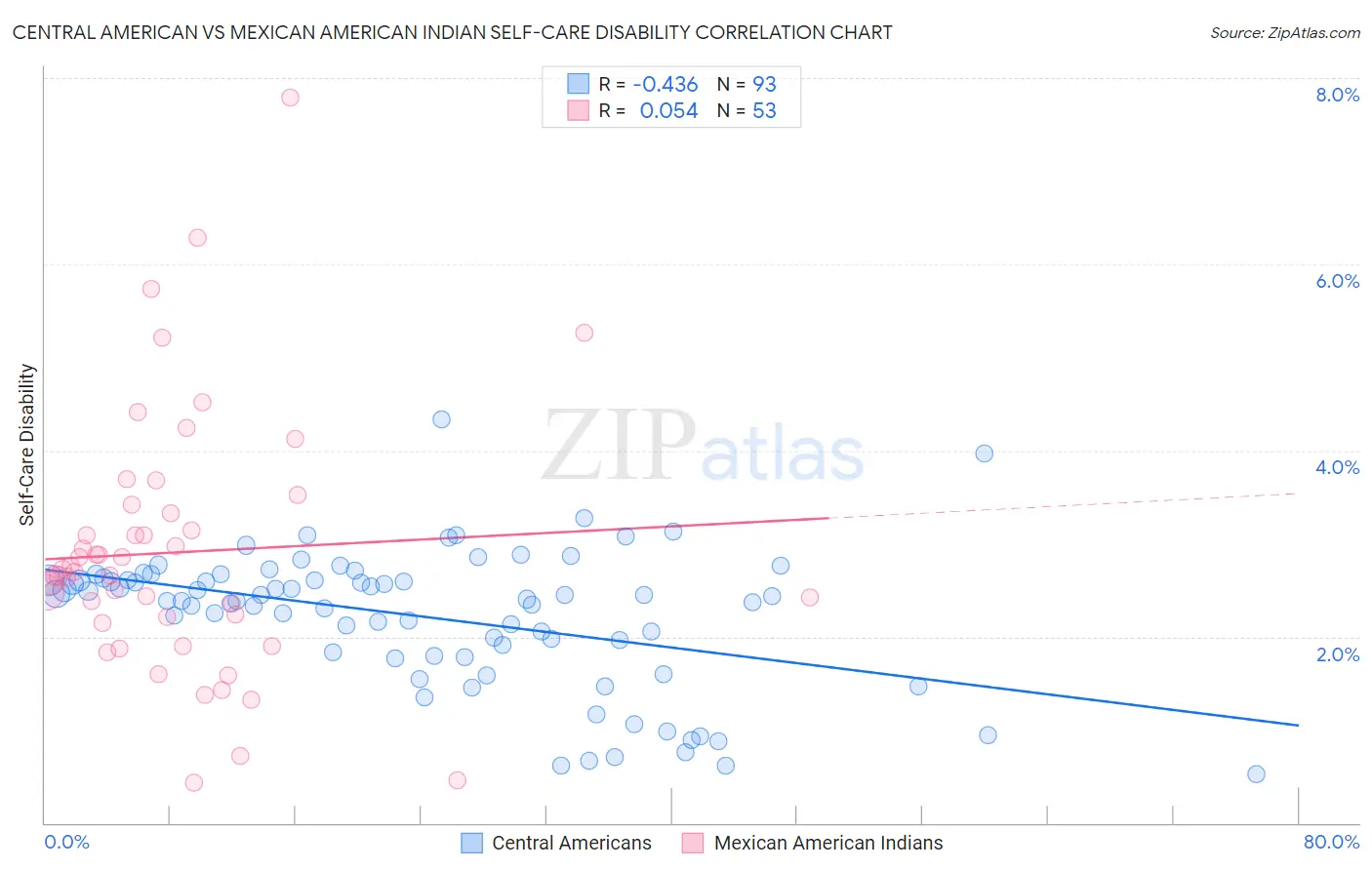Central American vs Mexican American Indian Self-Care Disability
COMPARE
Central American
Mexican American Indian
Self-Care Disability
Self-Care Disability Comparison
Central Americans
Mexican American Indians
2.5%
SELF-CARE DISABILITY
8.7/ 100
METRIC RATING
208th/ 347
METRIC RANK
2.6%
SELF-CARE DISABILITY
0.5/ 100
METRIC RATING
249th/ 347
METRIC RANK
Central American vs Mexican American Indian Self-Care Disability Correlation Chart
The statistical analysis conducted on geographies consisting of 503,524,295 people shows a moderate negative correlation between the proportion of Central Americans and percentage of population with self-care disability in the United States with a correlation coefficient (R) of -0.436 and weighted average of 2.5%. Similarly, the statistical analysis conducted on geographies consisting of 317,353,837 people shows a slight positive correlation between the proportion of Mexican American Indians and percentage of population with self-care disability in the United States with a correlation coefficient (R) of 0.054 and weighted average of 2.6%, a difference of 3.5%.

Self-Care Disability Correlation Summary
| Measurement | Central American | Mexican American Indian |
| Minimum | 0.52% | 0.43% |
| Maximum | 4.3% | 7.8% |
| Range | 3.8% | 7.4% |
| Mean | 2.2% | 2.9% |
| Median | 2.4% | 2.7% |
| Interquartile 25% (IQ1) | 1.8% | 2.2% |
| Interquartile 75% (IQ3) | 2.6% | 3.4% |
| Interquartile Range (IQR) | 0.81% | 1.2% |
| Standard Deviation (Sample) | 0.74% | 1.4% |
| Standard Deviation (Population) | 0.73% | 1.4% |
Similar Demographics by Self-Care Disability
Demographics Similar to Central Americans by Self-Care Disability
In terms of self-care disability, the demographic groups most similar to Central Americans are Malaysian (2.5%, a difference of 0.15%), French (2.5%, a difference of 0.16%), Alaskan Athabascan (2.5%, a difference of 0.23%), Immigrants from Russia (2.5%, a difference of 0.31%), and Panamanian (2.5%, a difference of 0.38%).
| Demographics | Rating | Rank | Self-Care Disability |
| Immigrants | South Eastern Asia | 12.9 /100 | #201 | Poor 2.5% |
| Slovaks | 12.6 /100 | #202 | Poor 2.5% |
| Immigrants | Lebanon | 12.4 /100 | #203 | Poor 2.5% |
| Immigrants | Bahamas | 11.9 /100 | #204 | Poor 2.5% |
| Immigrants | Russia | 11.0 /100 | #205 | Poor 2.5% |
| Alaskan Athabascans | 10.4 /100 | #206 | Poor 2.5% |
| French | 9.9 /100 | #207 | Tragic 2.5% |
| Central Americans | 8.7 /100 | #208 | Tragic 2.5% |
| Malaysians | 7.7 /100 | #209 | Tragic 2.5% |
| Panamanians | 6.4 /100 | #210 | Tragic 2.5% |
| Native Hawaiians | 5.1 /100 | #211 | Tragic 2.6% |
| Samoans | 5.1 /100 | #212 | Tragic 2.6% |
| Ecuadorians | 4.7 /100 | #213 | Tragic 2.6% |
| Immigrants | Honduras | 4.7 /100 | #214 | Tragic 2.6% |
| Immigrants | Thailand | 4.5 /100 | #215 | Tragic 2.6% |
Demographics Similar to Mexican American Indians by Self-Care Disability
In terms of self-care disability, the demographic groups most similar to Mexican American Indians are Portuguese (2.6%, a difference of 0.080%), Immigrants from Liberia (2.6%, a difference of 0.16%), Nicaraguan (2.6%, a difference of 0.23%), Immigrants from Albania (2.6%, a difference of 0.24%), and Immigrants from Bangladesh (2.6%, a difference of 0.24%).
| Demographics | Rating | Rank | Self-Care Disability |
| Spanish | 0.8 /100 | #242 | Tragic 2.6% |
| Hawaiians | 0.8 /100 | #243 | Tragic 2.6% |
| Yuman | 0.8 /100 | #244 | Tragic 2.6% |
| Immigrants | Western Asia | 0.6 /100 | #245 | Tragic 2.6% |
| Cheyenne | 0.6 /100 | #246 | Tragic 2.6% |
| Immigrants | Albania | 0.6 /100 | #247 | Tragic 2.6% |
| Nicaraguans | 0.6 /100 | #248 | Tragic 2.6% |
| Mexican American Indians | 0.5 /100 | #249 | Tragic 2.6% |
| Portuguese | 0.4 /100 | #250 | Tragic 2.6% |
| Immigrants | Liberia | 0.4 /100 | #251 | Tragic 2.6% |
| Immigrants | Bangladesh | 0.4 /100 | #252 | Tragic 2.6% |
| Immigrants | Haiti | 0.3 /100 | #253 | Tragic 2.6% |
| Haitians | 0.3 /100 | #254 | Tragic 2.6% |
| Tsimshian | 0.3 /100 | #255 | Tragic 2.6% |
| Immigrants | Central America | 0.3 /100 | #256 | Tragic 2.6% |